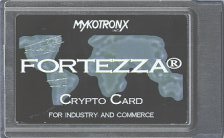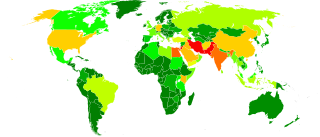Related Research Articles
In cryptography, key size or key length refers to the number of bits in a key used by a cryptographic algorithm.
Elliptic-curve cryptography (ECC) is an approach to public-key cryptography based on the algebraic structure of elliptic curves over finite fields. ECC allows smaller keys to provide equivalent security, compared to cryptosystems based on modular exponentiation in Galois fields, such as the RSA cryptosystem and ElGamal cryptosystem.

Public-key cryptography, or asymmetric cryptography, is the field of cryptographic systems that use pairs of related keys. Each key pair consists of a public key and a corresponding private key. Key pairs are generated with cryptographic algorithms based on mathematical problems termed one-way functions. Security of public-key cryptography depends on keeping the private key secret; the public key can be openly distributed without compromising security.

A digital signature is a mathematical scheme for verifying the authenticity of digital messages or documents. A valid digital signature on a message gives a recipient confidence that the message came from a sender known to the recipient.
Articles related to cryptography include:

RSA Security LLC, formerly RSA Security, Inc. and trade name RSA, is an American computer and network security company with a focus on encryption and decryption standards. RSA was named after the initials of its co-founders, Ron Rivest, Adi Shamir and Leonard Adleman, after whom the RSA public key cryptography algorithm was also named. Among its products is the SecurID authentication token. The BSAFE cryptography libraries were also initially owned by RSA. RSA is known for incorporating backdoors developed by the NSA in its products. It also organizes the annual RSA Conference, an information security conference.
The Clipper chip was a chipset that was developed and promoted by the United States National Security Agency (NSA) as an encryption device that secured "voice and data messages" with a built-in backdoor that was intended to "allow Federal, State, and local law enforcement officials the ability to decode intercepted voice and data transmissions." It was intended to be adopted by telecommunications companies for voice transmission. Introduced in 1993, it was entirely defunct by 1996.
In cryptography, Skipjack is a block cipher—an algorithm for encryption—developed by the U.S. National Security Agency (NSA). Initially classified, it was originally intended for use in the controversial Clipper chip. Subsequently, the algorithm was declassified.

Fortezza is an information security system that uses the Fortezza Crypto Card, a PC Card-based security token. It was developed for the U.S. government's Clipper chip project and has been used by the U.S. Government in various applications.
The National Security Agency took over responsibility for all US government encryption systems when it was formed in 1952. The technical details of most NSA-approved systems are still classified, but much more about its early systems have become known and its most modern systems share at least some features with commercial products.

Dorothy Elizabeth Denning is a US-American information security researcher known for lattice-based access control (LBAC), intrusion detection systems (IDS), and other cyber security innovations. She published four books and over 200 articles. Inducted into the National Cyber Security Hall of Fame in 2012, she is now Emeritus Distinguished Professor of Defense Analysis, Naval Postgraduate School.
Kleptography is the study of stealing information securely and subliminally. The term was introduced by Adam Young and Moti Yung in the Proceedings of Advances in Cryptology – Crypto '96. Kleptography is a subfield of cryptovirology and is a natural extension of the theory of subliminal channels that was pioneered by Gus Simmons while at Sandia National Laboratory. A kleptographic backdoor is synonymously referred to as an asymmetric backdoor. Kleptography encompasses secure and covert communications through cryptosystems and cryptographic protocols. This is reminiscent of, but not the same as steganography that studies covert communications through graphics, video, digital audio data, and so forth.
Strong cryptography or cryptographically strong are general terms used to designate the cryptographic algorithms that, when used correctly, provide a very high level of protection against any eavesdropper, including the government agencies. There is no precise definition of the boundary line between the strong cryptography and (breakable) weak cryptography, as this border constantly shifts due to improvements in hardware and cryptanalysis techniques. These improvements eventually place the capabilities once available only to the NSA within the reach of a skilled individual, so in practice there are only two levels of cryptographic security, "cryptography that will stop your kid sister from reading your files, and cryptography that will stop major governments from reading your files".

A hardware security module (HSM) is a physical computing device that safeguards and manages secrets, performs encryption and decryption functions for digital signatures, strong authentication and other cryptographic functions. These modules traditionally come in the form of a plug-in card or an external device that attaches directly to a computer or network server. A hardware security module contains one or more secure cryptoprocessor chips.

Network Security Services (NSS) is a collection of cryptographic computer libraries designed to support cross-platform development of security-enabled client and server applications with optional support for hardware TLS/SSL acceleration on the server side and hardware smart cards on the client side. NSS provides a complete open-source implementation of cryptographic libraries supporting Transport Layer Security (TLS) / Secure Sockets Layer (SSL) and S/MIME. NSS releases prior to version 3.14 are tri-licensed under the Mozilla Public License 1.1, the GNU General Public License, and the GNU Lesser General Public License. Since release 3.14, NSS releases are licensed under GPL-compatible Mozilla Public License 2.0.
Cryptography is the practice and study of encrypting information, or in other words, securing information from unauthorized access. There are many different cryptography laws in different nations. Some countries prohibit the export of cryptography software and/or encryption algorithms or cryptoanalysis methods. Some countries require decryption keys to be recoverable in case of a police investigation.

Cryptography, or cryptology, is the practice and study of techniques for secure communication in the presence of adversarial behavior. More generally, cryptography is about constructing and analyzing protocols that prevent third parties or the public from reading private messages. Modern cryptography exists at the intersection of the disciplines of mathematics, computer science, information security, electrical engineering, digital signal processing, physics, and others. Core concepts related to information security are also central to cryptography. Practical applications of cryptography include electronic commerce, chip-based payment cards, digital currencies, computer passwords, and military communications.
The following outline is provided as an overview of and topical guide to cryptography:

Bullrun is a clandestine, highly classified program to crack encryption of online communications and data, which is run by the United States National Security Agency (NSA). The British Government Communications Headquarters (GCHQ) has a similar program codenamed Edgehill. According to the Bullrun classification guide published by The Guardian, the program uses multiple methods including computer network exploitation, interdiction, industry relationships, collaboration with other intelligence community entities, and advanced mathematical techniques.

The Commercial National Security Algorithm Suite (CNSA) is a set of cryptographic algorithms promulgated by the National Security Agency as a replacement for NSA Suite B Cryptography algorithms. It serves as the cryptographic base to protect US National Security Systems information up to the top secret level, while the NSA plans for a transition to quantum-resistant cryptography.